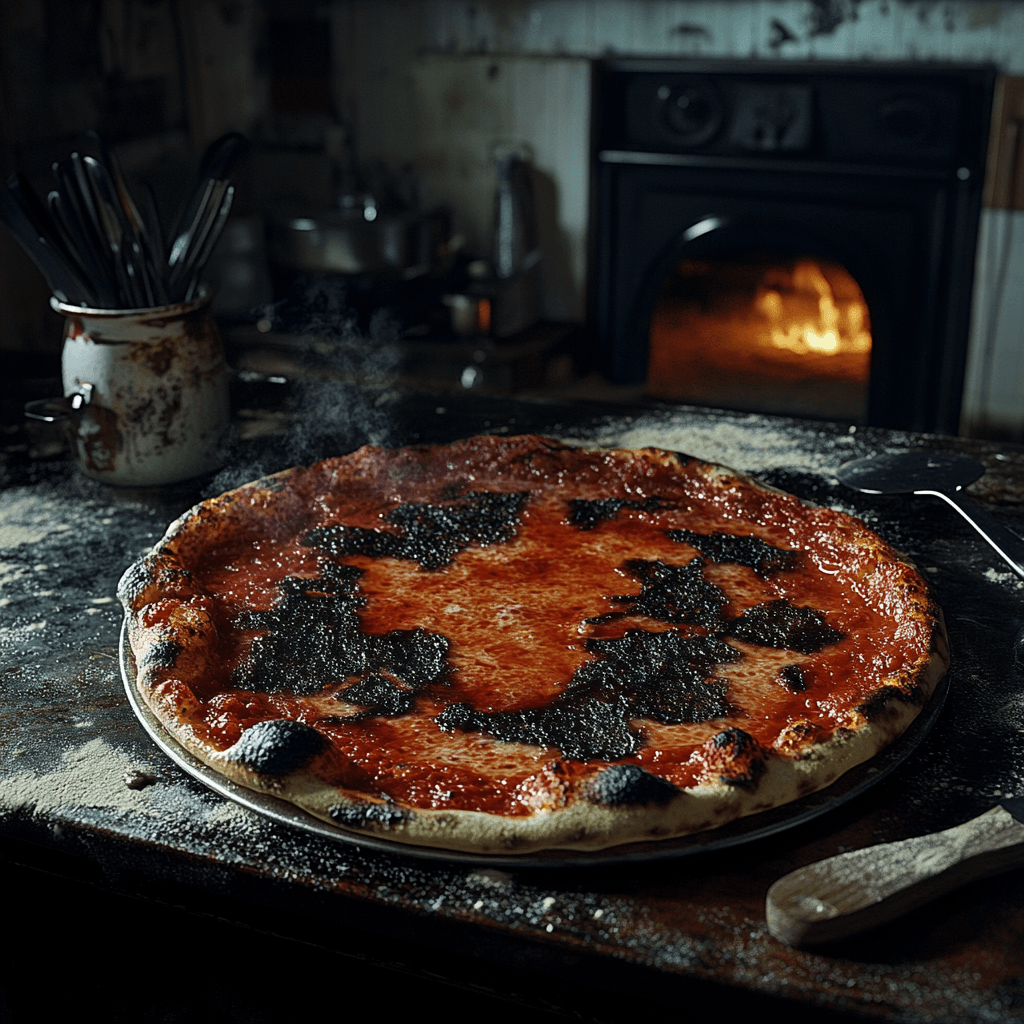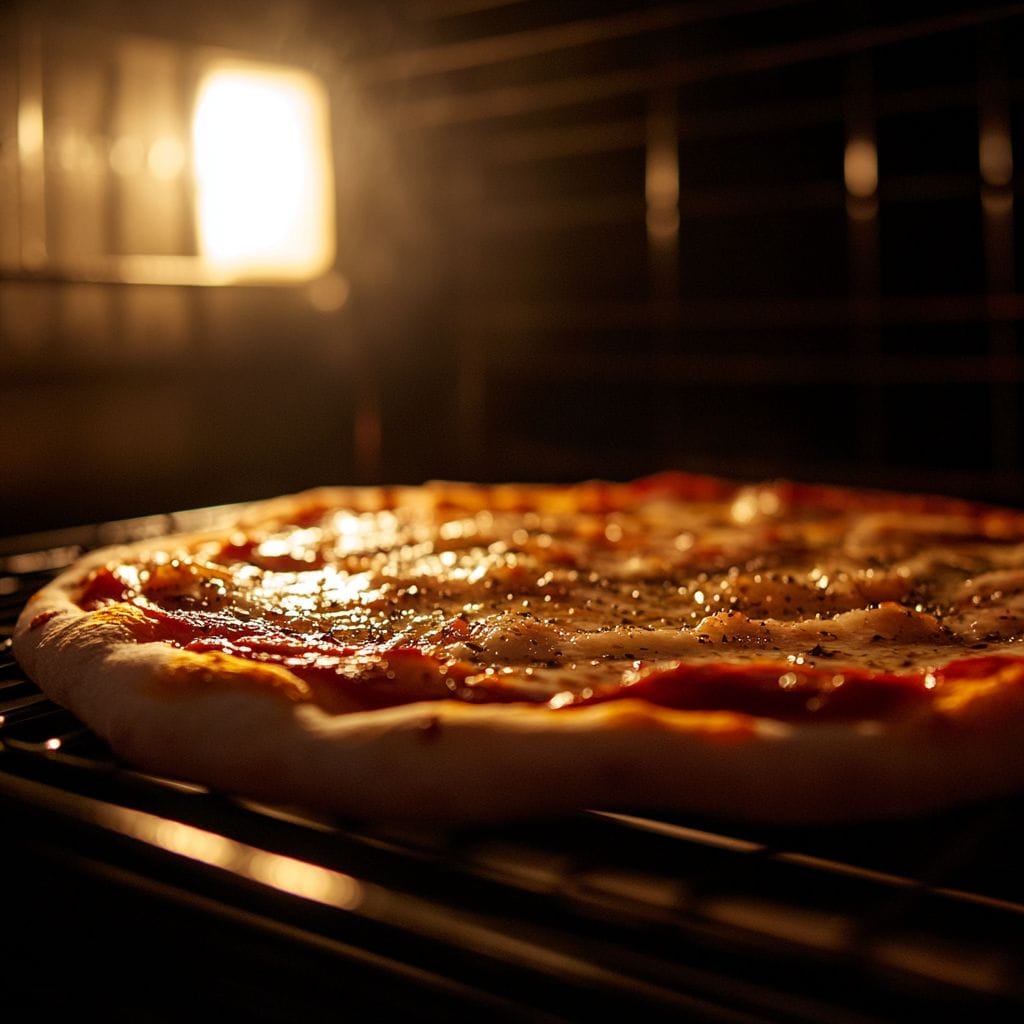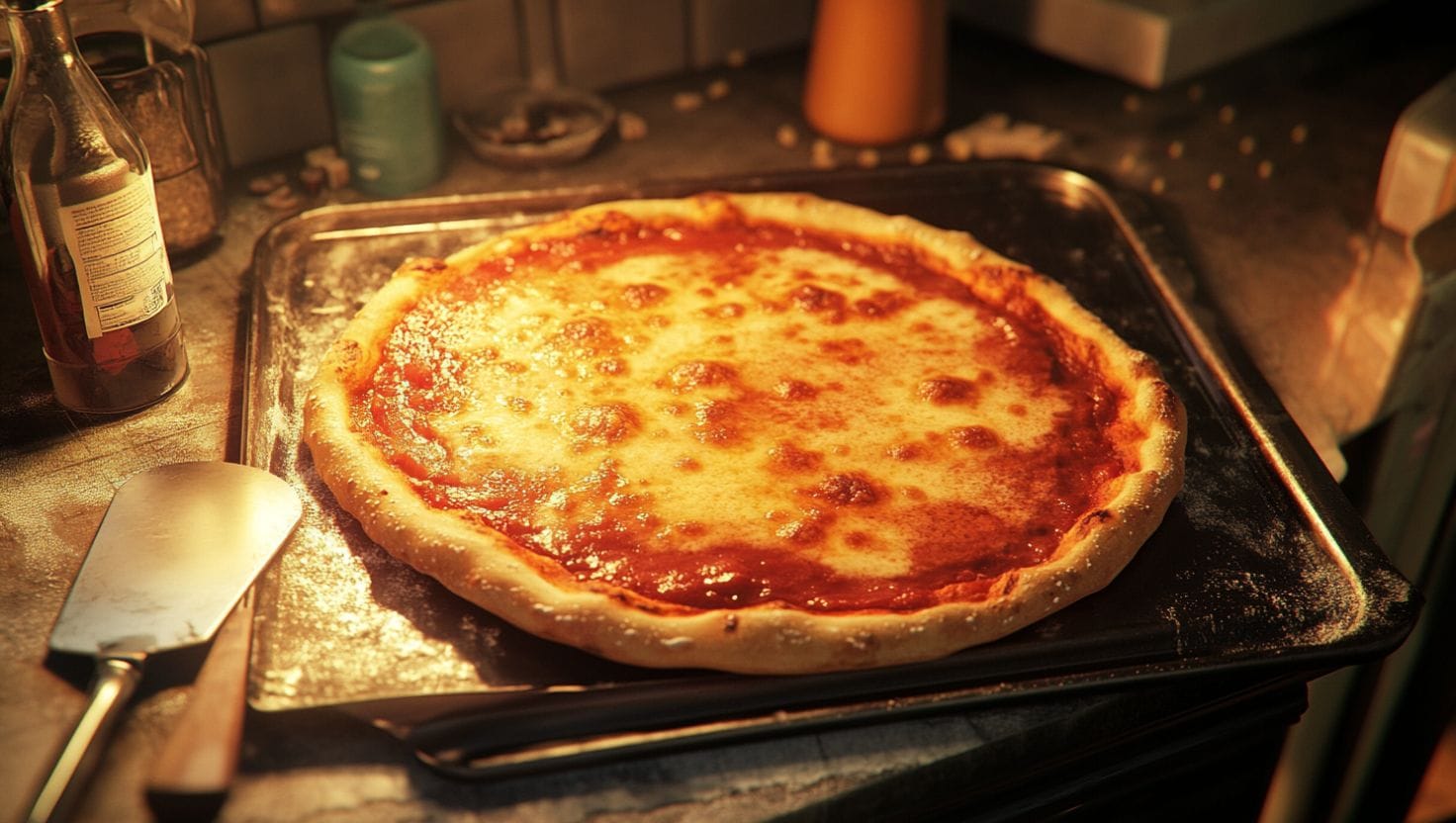When crafting the perfect pizza, you might notice a puzzling phenomenon: why pizza sauce burns but not crust. This intriguing difference boils down to the science of heat transfer, the nature of ingredients, and how each part of the pizza interacts with the baking process. While the crust turns golden and crisp, the sauce on top can easily char or blacken. Let’s dive deeper into this culinary mystery to uncover the reasons behind it and explore solutions for avoiding burnt sauce.
Key Takeaways
| Factor | Effect on Sauce | Effect on Crust |
|---|---|---|
| Sugar Content | Burns quickly due to caramelization | Contains minimal sugar, resists burning |
| Moisture Levels | Evaporates quickly, increasing burn risk | Retains moisture longer |
| Direct Heat Exposure | Absorbs heat directly from the oven | Gains insulation from pizza stone |
| Insulation Properties | Lacks insulation; heat impacts it directly | Dough provides natural heat barrier |
The Baking Science Behind Why Pizza Sauce Burns but Not Crust
Why Pizza Sauce Burns but Not Crust During Baking

The science of heat transfer and ingredient properties explains why sauce burns faster than crust. Pizza sauce often contains sugar and tomatoes, which react to high temperatures. Sugars caramelize at approximately 340°F, but extended exposure causes them to scorch. Similarly, tomatoes lose moisture under intense heat, leaving them vulnerable to burning.
In contrast, the dough structure insulates the crust. It absorbs heat gradually and distributes it evenly. Moreover, the crust’s position near the pizza stone or oven floor shields it from the direct heat that scorches sauce. This insulation ensures even cooking, keeping the crust from burning.
Thermal Properties of Dough in Why Crust Doesn’t Burn
Pizza dough’s unique composition helps it resist burning. Its mix of water, flour, and yeast creates a moist and dense structure that absorbs heat. As the dough cooks, it releases moisture slowly, cooling the surface and preventing overheating.
Meanwhile, the sauce’s thin layer remains exposed. This exposure, combined with direct oven heat, causes it to burn faster. To visualize this, think of the dough as a sponge soaking up heat gradually, while the sauce acts like a shallow puddle that evaporates quickly under similar conditions.
Understanding Heat Transfer in Why Pizza Sauce Burns Before Crust
Conductive vs. Convective Heat Transfer in Pizza Baking
Baking pizza involves two main types of heat transfer: conduction and convection. Conduction happens when heat travels through solid surfaces, such as the pizza stone or baking tray, into the crust. This method provides steady, uniform heat that ensures the crust cooks thoroughly without scorching.
In contrast, convection occurs as hot air circulates inside the oven. The sauce, positioned on top, absorbs this circulating heat directly. High oven temperatures amplify this effect, making the sauce more susceptible to burning. For a deeper dive, explore the science of heat transfer in cooking.
Why Pizza Sauce Burns but Not Crust: A Detailed Look at Heat Exposure
Direct heat exposure also explains why sauce burns more readily. Unlike dough, which gains some protection from its position, sauce sits on the pizza’s surface and absorbs radiant heat from the oven’s elements. This exposure, combined with its higher sugar content and lower moisture levels, accelerates burning.
Pro Tip: Covering your pizza with foil during the last few minutes of baking shields the sauce from intense heat while allowing the crust to finish cooking perfectly.
The Role of Ingredients in Why Pizza Sauce Burns But Not Crust
Sugar Content and Why Pizza Sauce Burns Quickly
Sugar content plays a major role in burnt pizza sauce. Whether the recipe includes added sugar or relies on naturally occurring sugars in tomatoes, both are heat-sensitive. When heated past their caramelization point, sugars turn golden-brown but will eventually char if exposed to prolonged high temperatures.
Reducing the amount of sugar in your sauce recipe can help prevent burning. Alternatively, you can opt for tomatoes with lower sugar content or balance the sauce’s flavor with herbs instead of sweeteners.
Moisture Levels and Their Role in Why Pizza Sauce Burns First
Moisture levels significantly influence whether your pizza sauce burns. Water content helps regulate temperature by absorbing heat, which delays burning. However, as the sauce loses moisture during baking, it becomes more likely to char.
You can mitigate this by choosing sauces with higher initial moisture or applying a thicker sauce layer to the pizza. These techniques provide an additional buffer, reducing burn risk.
Pro Tip: Use fresh, ripe tomatoes to naturally enhance the moisture content of your sauce, which lowers the likelihood of burning without sacrificing flavor.
By focusing on these factors, you can better understand why pizza sauce burns but not crust. Making adjustments to your ingredients and baking techniques ensures your pizza emerges from the oven with a perfectly golden crust and a flavorful, unburnt sauce.
Temperature Dynamics in Why Pizza Sauce Burns but Not Crust
Why Pizza Sauce Burns but Not Crust at High Temperatures
High oven temperatures create the perfect storm for pizza sauce to burn while the crust remains golden. Pizza ovens, especially traditional wood-fired ones, reach temperatures of 700°F or more. At these extremes, the sugar and moisture in the sauce face intense heat exposure, while the dough benefits from its insulating properties.
Moreover, the dough starts cooking from the bottom, absorbing heat from the pizza stone. This gradual heat transfer allows the crust to bake evenly, avoiding sudden temperature spikes. In contrast, the sauce, sitting at the surface, is exposed to radiant heat from above, where temperatures are most intense.
For a fascinating look at the physics of cooking the best pizza, read this expert analysis. The study highlights how managing oven heat can produce a perfectly balanced pizza without burning the sauce.
The Role of Even Heat Distribution in Preventing Burnt Sauce
Heat distribution plays a critical role in determining whether pizza sauce burns. Uneven heat from an improperly preheated oven can create hot spots that scorch the sauce. A pizza stone, which retains and spreads heat evenly, minimizes these risks.
Additionally, different oven surfaces can dramatically affect how sauce and crust bake. Steel surfaces, for example, transfer heat more aggressively than stone, increasing the likelihood of sauce burns. Choosing the right equipment and preheating thoroughly can ensure even cooking across the pizza.
Preventing Burnt Pizza Sauce: Tips and Techniques
Choosing the Right Sauce Consistency to Prevent Burning
The texture and thickness of pizza sauce significantly impact its likelihood of burning. Thinner sauces evaporate quickly, leaving a dry, exposed layer prone to charring. Opting for a slightly thicker consistency can help retain moisture longer, acting as a barrier against intense heat.
Additionally, you can reduce the risk of burning by using fresh, unsweetened tomatoes and incorporating hydrating ingredients like olive oil or a splash of water. These adjustments ensure the sauce stays moist throughout the baking process.
Why Pizza Sauce Burns but Not Crust: Prevention Tips
Practical steps can prevent pizza sauce from burning without affecting the crust’s texture. Spreading a slightly thicker layer of sauce on the pizza can protect it from direct heat. Lowering the oven temperature or reducing cooking time also helps. For best results, bake pizzas at a consistent temperature of 500°F to 550°F, where both sauce and crust cook evenly.
If you’ve struggled with burnt sauce before, this guide on tips to avoid burnt pizza sauce provides helpful insights. It emphasizes balancing heat exposure with moisture retention to achieve a flawless finish.
Pro Tip: Try baking your pizza in stages. Parbake the crust first for a few minutes before adding sauce and toppings. This technique ensures the crust achieves a head start without subjecting the sauce to prolonged heat.
Exploring Dough’s Role in Why Crust Doesn’t Burn
Dough Thickness and Insulation
The thickness of pizza dough directly impacts its heat resistance. Thicker crusts create a more substantial barrier between the sauce and the pizza stone. This extra layer slows down heat absorption, ensuring the dough cooks evenly without burning.
Thinner crusts, while crispier, expose the sauce to higher temperatures for longer periods. Adjusting the thickness to suit your oven’s heat dynamics can make all the difference in achieving a perfectly balanced pizza.
Why Pizza Crust Bakes Slower Than Sauce
The slower baking process of crust compared to sauce results from its composition and placement. The dough’s high water content delays its temperature rise, as the water absorbs heat during evaporation. Meanwhile, the crust’s position on the oven floor shields it from direct radiant heat, further slowing its cooking.
Interestingly, this dynamic shifts in commercial ovens with advanced heat distribution systems, where crust and sauce cook more evenly. Home cooks can mimic this by using a pizza steel or stone and placing the pizza closer to the oven’s center.
Baking Techniques to Avoid Burnt Sauce on Pizza
The Importance of Preheating Pizza Stones

Preheating your pizza stone or steel is essential for even heat distribution. A well-heated surface prevents sudden temperature spikes that can burn sauce. Place the stone in the oven for at least 30 minutes before baking to ensure it reaches the correct temperature.
Preheating also helps maintain oven temperature when you slide in the pizza. Without it, the temperature drops quickly, creating uneven heat that burns the sauce while undercooking the crust.
Adjusting Baking Times for Optimal Results
Timing is everything when baking pizza. Monitor the sauce and crust closely, and adjust the cooking time based on your oven’s heat output. Shortening the bake time slightly can protect the sauce while still cooking the crust to perfection.
If you use a broiler for finishing, reduce the time under direct heat. Overexposing the pizza to the broiler can char the sauce within seconds. Keep an eye on it, and rotate the pizza halfway through for even cooking.
Pro Tip: Experiment with different racks in your oven. Baking pizza on the lower rack reduces the impact of radiant heat from the top, preserving the sauce.
Through thoughtful preparation and a few strategic adjustments, you can resolve the issue of why pizza sauce burns but not crust. Following these techniques ensures your pizza achieves the ideal balance of flavors, textures, and visual appeal.
Common Mistakes Leading to Burnt Pizza Sauce
Excessive Sugar in Pizza Sauce
Adding too much sugar to pizza sauce is a common mistake that leads to burning. Sugar caramelizes when heated, but excessive amounts quickly transition from caramelized to burnt under high oven temperatures. This issue is especially problematic in ovens set to 500°F or higher, which are typical for pizza baking.
To avoid this problem, reduce added sugar in your sauce recipe. Instead, rely on the natural sweetness of fresh tomatoes. A touch of olive oil can also balance the flavor without increasing burn risk. Additionally, taste-test your sauce before baking to ensure it’s not overly sweet.
Overexposing Pizza Sauce to Direct Heat
Another mistake that causes burnt sauce is placing the pizza too close to the heating element. Whether you’re using a broiler or baking in a convection oven, excessive radiant heat on the sauce’s surface accelerates burning.
For better results, position your pizza on the middle or lower oven rack. This placement reduces exposure to direct heat while allowing the crust to cook evenly. If you use a broiler for finishing, limit the time under direct heat to no more than 30 seconds.
To refine your pizza-making technique, explore more on pizza baking techniques, including tips for perfect heat distribution.
FAQs About Why Pizza Sauce Burns but Not Crust
- Why does sugar cause pizza sauce to burn quickly?
Sugar caramelizes at 340°F and burns at even slightly higher temperatures. High heat, combined with prolonged exposure, makes sugar in pizza sauce prone to charring. Reducing sugar or using low-sugar tomato varieties helps mitigate this issue. - Can lower oven temperatures prevent sauce burns?
Yes, baking at lower temperatures (around 450°F) can prevent sauce burns. However, it may extend cooking times, which could impact crust texture. A balance between temperature and bake time is essential. - Does using a pizza stone reduce sauce burning?
Absolutely. A preheated pizza stone ensures even heat distribution, preventing hot spots that can scorch the sauce. It also helps the crust bake more efficiently, reducing the overall exposure time for the sauce. - Are there alternative toppings to reduce burning?
Adding toppings like cheese over the sauce can protect it from direct heat. Cheese creates a barrier, helping to retain sauce moisture while also absorbing radiant heat from the oven. - How does crust composition impact burning dynamics?
Crusts with higher water content and proper thickness act as a heat insulator, baking slower than sauce. This natural resistance to rapid heat prevents burning and creates a balanced pizza.
Pro Tip: Use an infrared thermometer to measure your oven and pizza stone’s temperature. Ensuring consistent heat levels minimizes burning risks for both sauce and crust.
Final Thoughts on Why Pizza Sauce Burns but Not Crust
Understanding the science behind why pizza sauce burns but not crust helps elevate your pizza-making skills. By addressing the key factors—heat transfer, ingredient composition, and baking techniques—you can create a perfectly balanced pizza with a flavorful, unburnt sauce and a golden, crispy crust.
Experimenting with oven settings, using high-quality ingredients, and preheating your baking surfaces are all critical steps to achieving optimal results. Don’t let burnt sauce discourage you from crafting your dream pizza. Instead, use the tips and insights shared here to turn every pizza into a masterpiece.
Try these methods in your kitchen today, and enjoy the satisfaction of making a pizza that’s perfectly baked from the first bite to the last slice.

